 |
Animal Super-Dads
In nature, the single-parent family is the overwhelming rule—and that parent
is almost always female. From building a nest and gathering food to giving
birth and protecting their young, females do it all. Male involvement rarely
extends beyond the moment of conception.
There are, however, a few notable exceptions to this rule. In 90% of bird
species, the male provides some form of parental care. In fishes, males
occasionally take on a custodial role at the nest site. And for animals living
in harsh environments, the efforts of two parents are often required for the
young to survive.
Click on the exceptional animal dads below to find out what role they play in
caring for their young.
waterbug | stickleback | poison arrow frog
deermouse | emperor penguin | red fox | sandpiper
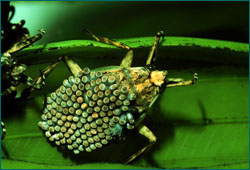 Male parenting is virtually unknown in insects, but one striking
exception is the giant water bug. The male becomes a virtual beast of
burden, beginning with the mating process, when the female latches onto him
until she is ready to lay her eggs. She will cement as many as 150 eggs onto
his back and then depart. The male will carry this load for the next month,
aerating his cargo by performing elaborate deep knee bends and warding off
parasites by sunning himself at the water's edge. After three weeks, the eggs
will have tripled in size and the male will stop eating altogether, so as to
avoid accidentally eating his new offspring.
Male parenting is virtually unknown in insects, but one striking
exception is the giant water bug. The male becomes a virtual beast of
burden, beginning with the mating process, when the female latches onto him
until she is ready to lay her eggs. She will cement as many as 150 eggs onto
his back and then depart. The male will carry this load for the next month,
aerating his cargo by performing elaborate deep knee bends and warding off
parasites by sunning himself at the water's edge. After three weeks, the eggs
will have tripled in size and the male will stop eating altogether, so as to
avoid accidentally eating his new offspring.
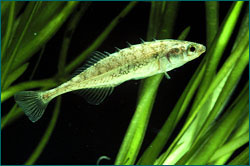 Sticklebacks are carnivorous river fish who enjoy eating, among other
delicacies, eggs of other stickleback fish. The job of protecting the
fertilized eggs falls to the male. Using secretions from his kidneys to glue
together odd bits of vegetation, the male builds a sturdy nest. After the
female lays her eggs, the male fertilizes them and flattens them into a sheet
against the bottom of the nest, so that another layer of eggs may be laid on
top. Up to seven layers of fertilized eggs may be collected by the male over
a period of one to two days. Next, he aerates the eggs by fanning water
through the nest. He inspects his clutch constantly and will pick out and eat
any eggs that die or become moldy. Once the young sticklebacks hatch, the male
protects them for up to a week by gathering wayward fry in his mouth and
spitting them back into the nest.
Sticklebacks are carnivorous river fish who enjoy eating, among other
delicacies, eggs of other stickleback fish. The job of protecting the
fertilized eggs falls to the male. Using secretions from his kidneys to glue
together odd bits of vegetation, the male builds a sturdy nest. After the
female lays her eggs, the male fertilizes them and flattens them into a sheet
against the bottom of the nest, so that another layer of eggs may be laid on
top. Up to seven layers of fertilized eggs may be collected by the male over
a period of one to two days. Next, he aerates the eggs by fanning water
through the nest. He inspects his clutch constantly and will pick out and eat
any eggs that die or become moldy. Once the young sticklebacks hatch, the male
protects them for up to a week by gathering wayward fry in his mouth and
spitting them back into the nest.
 Paternal care in amphibians is extremely rare. One exception is found in a
family of neotropical frogs. The male Panamanian poison-arrow frog is
responsible for sitting on the eggs and keeping them hydrated with moisture
from his skin. He also bears the job of carrying the newly-hatched tadpoles to
water on his back.
Paternal care in amphibians is extremely rare. One exception is found in a
family of neotropical frogs. The male Panamanian poison-arrow frog is
responsible for sitting on the eggs and keeping them hydrated with moisture
from his skin. He also bears the job of carrying the newly-hatched tadpoles to
water on his back.
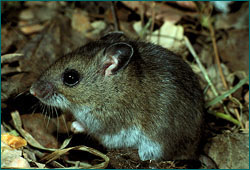 Deer mice dads pitch in by guarding their young when the female goes off
to feed. Males have been observed hovering over their young, surrounding them
with nesting material, and even washing them. Studies of rodent species have
shown that pups reared in the company of both parents survive better and grow
faster that those reared only by the mother.
Deer mice dads pitch in by guarding their young when the female goes off
to feed. Males have been observed hovering over their young, surrounding them
with nesting material, and even washing them. Studies of rodent species have
shown that pups reared in the company of both parents survive better and grow
faster that those reared only by the mother.
 The male emperor penguin is entirely responsible for incubating his
mate's precious egg over the long Antarctic winter. He does this inland, while
the female returns to the sea to feed. His success depends entirely on his fat
stores; if a male gets too thin, he will abandon his egg and try to get back to
the ocean. Big fat males are consequently creatures of great worth and females
have been observed fighting over them. Once the egg hatches, the male produces
milk from gland in his esophagus to feed his chick.
The male emperor penguin is entirely responsible for incubating his
mate's precious egg over the long Antarctic winter. He does this inland, while
the female returns to the sea to feed. His success depends entirely on his fat
stores; if a male gets too thin, he will abandon his egg and try to get back to
the ocean. Big fat males are consequently creatures of great worth and females
have been observed fighting over them. Once the egg hatches, the male produces
milk from gland in his esophagus to feed his chick.
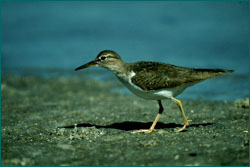 Spotted sandpipers are one of a few species of birds that are sex-role
reversed; females are aggressive and play the more active role in courtship,
while males provides most or all of the care for the young. Studies of the
birds' hormones have shown that males have higher levels of prolactin than
females—particularly after a clutch of eggs has been laid. Males will sit
on the eggs for a 21-day incubation period and then tend the fledglings for
another 21 days. Females may offer some assistance if the clutch is her last
of the season, but she will be quick to shirk her duties if an opportunity
arises to take another mate.
Spotted sandpipers are one of a few species of birds that are sex-role
reversed; females are aggressive and play the more active role in courtship,
while males provides most or all of the care for the young. Studies of the
birds' hormones have shown that males have higher levels of prolactin than
females—particularly after a clutch of eggs has been laid. Males will sit
on the eggs for a 21-day incubation period and then tend the fledglings for
another 21 days. Females may offer some assistance if the clutch is her last
of the season, but she will be quick to shirk her duties if an opportunity
arises to take another mate.
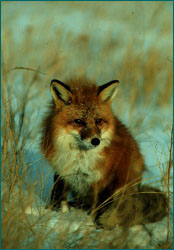 The male Red Fox is a devoted mate and father. Not only does he supply
his vixen with fresh food every four to six hours while she nurses her pups,
but he is equally dedicated to teaching his offspring survival skills. Males
will bury food near the den to train pups how to sniff and forage and will play
ambush games with them to teach self-defense.
The male Red Fox is a devoted mate and father. Not only does he supply
his vixen with fresh food every four to six hours while she nurses her pups,
but he is equally dedicated to teaching his offspring survival skills. Males
will bury food near the den to train pups how to sniff and forage and will play
ambush games with them to teach self-defense.
Photos: (1) © Gerald & Buff Cors/Visuals Unlimited;
(2) © Patrice Ceisel/Visuals Unlimited; (3) © A. Kerstitch/Visuals Unlimited;
(4) © John Gerlach/Visuals Unlimited; (5) © Kjell B. Sandved/Visuals Unlimited;
(6) © Ron Spomer/Visuals Unlimited; (7) © Gil Lopez-Espina/Visuals Unlimited.
Seahorse Home | Crusader | Basics | Superdads
Roundup | Resources | Table of Contents
|